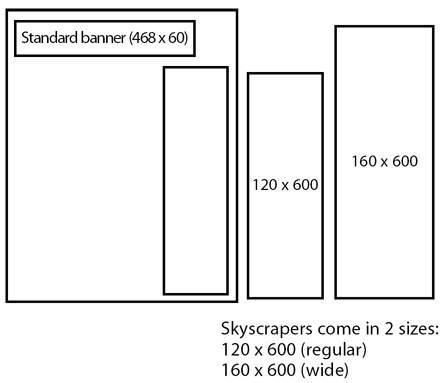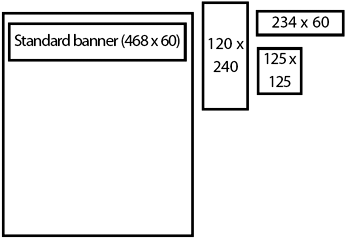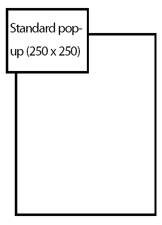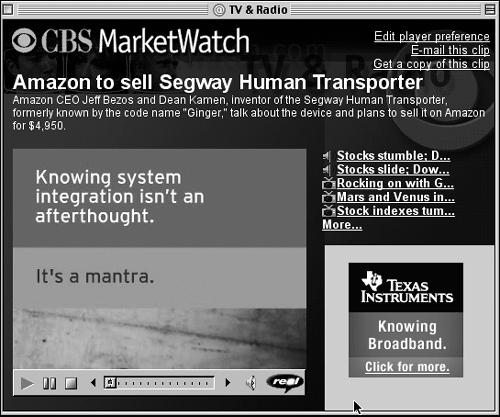types of ads
| Since October 1994 when HotWired first launched and brought advertising to the web the basic unit of online advertising has been the banner ad, a simple strip along the top of a web page. Over time, the banner has morphed into many shapes and sizes, and bent to accommodate a range of technologies, from simple animated graphics to increasingly complex interactive programs. But other methods some more intrusive, some less are nipping at the heels of the banner. Techniques like pop-ups, skyscrapers, and text-based ads have all been used with some success. And while nothing has yet toppled the supremacy of the banner, they've all become part of the online advertiser's arsenal. Types of online ads:
bannersWhile different sizes have been introduced and other more innovative approaches attempted, the banner, for better or worse, remains the bread-and-butter of web advertising. The basic banner is a horizontal strip, generally placed at the top of a web page. But over the years, alternate sizes and shapes have developed, with varying levels of success. Because advertisers usually develop banners that appear across multiple sites, it was essential early on to regulate the size of ads. Toward this end, the Internet Advertising Bureau was founded in 1996. Among other things, the IAB produces a set of standards governing the size and shape of ad banners. (See online ad standards, p. 303.) buttonsThe distinction between banners and buttons can seem arbitrary at first. Basically, buttons are smaller and simpler. Banners may be and invariably are animated, while buttons are usually static or perhaps primitively animated (with, say, blinking text). skyscrapersAlthough some may argue that any banner-like ad should be called, simply, a banner (modified perhaps by the descriptive "vertical banner," "half banner," etc.) different names have evolved for different styles of banner ads, such as skyscrapers. As their name implies, skyscrapers are large, vertical ads that tower over a web page, usually running down the right-hand side, adjacent to the content. Skyscrapers. This ad for M&M's candy, which appeared on iVillage, takes advantage of the skyscraper's dramatic dimensions to tell a story and draw the user's eye. pop-ups and leave-behindsAs new online technologies develop, advertising models follow. Pop-up ads take advantage of the technology, JavaScript, introduced by Netscape in 1996. (See learning to use javascript, p. 165.) JavaScript allows the browser window to spawn a new (usually smaller) window, which "pops up" on the screen, along with the user's existing window. This trick is sometimes used by sites to enhance navigation or functionality the same way many software applications employ "floating toolbars." But more often than not, it's used for promotional messages or pop-up ads. Leave-behinds also appear in a pop-up window, but these ads pop up as the user exits a site. A parting gift? Or the online way of saying, "And STAY out!" You make the call. "rich-media" adsRich-media ads take advantage of new, Java-based technologies to embed a richer, more interactive experience into a banner ad. Rich-media ads are usually shaped like a thick rectangle and sit in the middle of a web page. They usually entice the viewer with quirky games or eye-grabbing visuals. The advantage of rich media is that it makes possible exciting ads that engage the user more completely than a banner ad ever could. But the drawback is in the technology: It can be sloooow. At times, the entire web page will hang as the ad loads or fails to load, as the case may be. And this doesn't help anyone: The user, the advertiser, and the site all lose. text adsText ads are exactly what they sound like: short, pithy lines of text, used to succinctly and simply promote a site or product. These low-key pitches are used on a wide variety of sites, but they find the most success on search engines, where they can be targeted precisely toward those users looking for a site like theirs. Leave-behinds. Subtle, they are not. Nothing annoys users more than pop-up ads, except maybe leave-behinds, like this one, which pop up as you exit a site. They definitely get seen, but you have to decide whether the exposure is worth the ill will. sponsored linksSponsored links appear as a short, simple line of text on a web page, with words like "Find a car" or "Cheap airplane tickets," etc. These links, which draw the user back to an advertisers' site, often appear under the heading "Sponsored links," but they may also be integrated into a site without any particular label. I have mixed feelings about sponsored links. On one hand, they're the least invasive ad available online. On the other hand, they can be the most insidious because it's so difficult to distinguish them from a "normal" link. While banner ads are generally purchased on the CPM model (meaning that payment is based on the number of times the ad is viewed), sponsored links are usually purchased on a CPC or cost-per-click basis. This means the advertiser only pays when a customer clicks through the link. endorsementsEndorsements usually present themselves on a web site by a small line of text followed by a logo, which announce the web site's preference for or use of a particular product. You might see the words, "Powered by Compaq" on Yahoo's front door, or the words "HotBot prefers Visa" on your favorite search engine.
Endorsements can be a tricky proposition for a web site. On one hand, they can be easy money. Companies often are willing to pay a mint (tens of thousands of dollars) for this kind of placement. On the other hand, sites should be careful about handing out endorsements, lest they lose their meaning. sponsorshipsThe idea for sponsorships was borrowed from other media, especially broadcast TV. In the early days of television, many programs were sponsored entirely by a single advertiser, creating a strong link between the program's content and the product or company that made it possible. Few can forget Mutual of Omaha's "Wild Kingdom," or "The Milton Berle Show," which was alternately named "Texaco Star Theater," "The Buick-Berle Show," and "Kraft Music Hall" depending on that year's sponsor over the course of its long run in the 1950s. This sponsorship model is still used widely by public broadcasting stations (TV and radio) that don't accept conventional advertising. And it's used on commercial TV for spot sponsorships, in which advertisers sponsor particular segments of a program the weather report during a news broadcast, for example, or the instant replays during a sports game. Print media also dabble in sponsorships. Magazines may produce special issues funded by a single advertiser or run an ongoing feature linked to a single sponsor. For example, the San Francisco newspaper, SF Weekly, always runs a list of upcoming concerts, sponsored by Miller Beer. On the web, both models of sponsorship complete and partial are used. Some sites, like HotWired's Dream Jobs (circa 1995) were entirely sponsored by a single client, whose ads appeared in all available banner spaces. Others use partial sponsorships to finance a site feature, such as "Email this to a friend." product placementPaid product placement has become a staple in film and TV, where actors may conspicuously display a Coke can or make an off-hand remark about using, say, pore strips to keep their skin blemish-free (seriously, these things happen). Online, these opportunities are less common. But as visual, time-based media becomes more common, product placement may take its place among the roster of online advertising options. video adsAlthough it's still quite rare, some sites with video-style content TV stations being the best example will incorporate short video ads before or during the video clip or animation being screened. interstitialsAs a web producer at HotWired, the mere mention of the word "interstitial" would make my face twitch. These ads, which never have been widely implemented, appear as a full-page diversion between two pages on a web site. So when a user clicks on a link, she's first taken to the ad, which runs its course and then "pushes" her to the page she really wanted. Basically, we're looking at a TV model of fully interruptive advertisements (not that there's anything wrong with that, theoretically). The appeal to advertisers is obvious: they get the full attention of the user, and the full browser window to play with. But the drawbacks are severe. First, web users as opposed to TV viewers or radio listeners are prone to rapid departures; they expect lightning-fast results and are likely to bolt if they have to wait too long for the page they requested. They're also prone to disorientation. If the interstitial page takes too long to load or too long to leave, they may well lose their train of thought and pick up something else instead. Finally, interstitials are technically difficult which is probably why they haven't been implemented widely. |
EAN: 2147483647
Pages: 195






